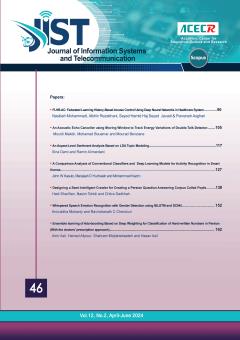Today, the hand-written data volume is huge, which prohibits these data from being manually converted into electronic files. During the past years, different types of solutions were developed to convert machine learning-based handwritten data. Each method classifies or
More
Today, the hand-written data volume is huge, which prohibits these data from being manually converted into electronic files. During the past years, different types of solutions were developed to convert machine learning-based handwritten data. Each method classifies or clusters the data according to the data type and application. In the present paper, a new approach is presented based on compound methods and deep learning for the classification of Persian handwritten data, where a deeper investigation is made of the data in basic learning by combining the Ada boosting and convolution. The present study aims at providing a new technique for classification of the images of handwritten Persian numbers. The structure of this technique is founded on Ada Boosting, which in turn, is based on weak learning. This technique improves learning by iteration of the weak learning processes and updating weights. In the meantime, the proposed method tried to employ stronger learners and present a stronger algorithm by combining these strong learners. The method was assessed on the standard Hoda dataset containing 60000 training data. The results show that the proposed method has a lower error rate than the previous methods by more than 1%. In the future, by developing basic learner, new mechanisms can be provided to improve the results by new types of learning.
– Today, the hand-written data volume is huge, which prohibits these data from being manually converted into electronic files. During the past years, different types of solutions were developed to convert machine learning-based handwritten data. Each method classifies or clusters the data according to the data type and application. In the present paper, a new approach is presented based on compound methods and deep learning for the classification of Persian handwritten data, where a deeper investigation is made of the data in basic learning by combining the Ada boosting and convolution. The method was assessed on the standard Hoda dataset containing 60000 training data. The results showed that the error rate of the method has decreased by more than 1% compared to the previous methods.
Manuscript profile


